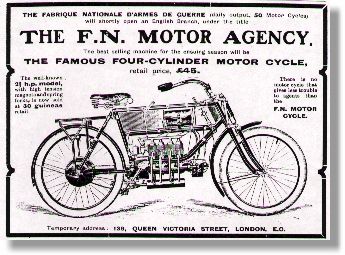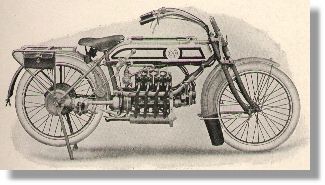Most books on the history of motor cycling mention the four cylinder FN motor cycle. Unfortunately the story sometimes gets a bit muddled, and because of the inter-changeability of parts between the different veteran models and the difficulty in getting just the right parts for a restoration, quite a few bitsas exist. What follows is an attempt to cover (very briefly) the evolution of the pre-war FN, drawn from various bits and pieces I have collected. Probably the best reference for FNs of this era is Claude Reynaud's 1991 book "Le Mythe des 4 Cylindres en Ligne 1904-1954" which has a lovely collection of catalogue photos year by year. The earliest four-cylinder FN was used by Osmont on a widely publicised journey through Europe in November 1904, terminating at the First World "Salon de l'Auto" in Paris. This machine was 363 cc (45 mm x 57 mm) and like all pre-1914 FNs had automatic inlet valves. Except that the front fork was unsprung, the machine was similar to the first production model for 1905: the "Type A". The major dating points for this model are the finless cylinder heads, the absence of windows to check the oil level in the crankcase, the straight inlet manifold that curves down to meet the carburettor mounted behind the cylinders. There were several variations of the oiling system in the first year or so of production: the externally mounted oil pump is not seen on early models, and some sported an unusual oil distribution device on the left side of the engine. Two very nice Type A models are pictured in Hodgdon's book "Golden Age of the Fours".
The Type B (1905/6) had a new straight inlet manifold housing a long rotating-barrel throttle, and a new type of carburettor. This arrangement carried on until the redesign in 1910. Type C (1905/6) models were externally similar to Type B, but detail changes included a large oil-retaining ring on the rear of the crankshaft, and two (rather than 3) plungers in the flywheel spring drive. For the Type D (later 1906) the capacity was increased to 410 cc by a change in bore size to 48 mm (although all the ones I've seen are 50 mm), and the exhaust valves were increased in size. Around this time windows appeared in the cast-iron crankcases, and the oil pump was located on the right side of the oil tank. With the Type E (1917) an extra air inlet appeared at the rear end of the inlet manifold, and the connecting rods were fitted with bronze bushes. While the Type F (1908) appears at first glance identical with the Type E, a major change was the reduction of the height of the tanks from 6 inches to about 4 1/2 inches. To allow for the shorter steering head, the side plates of the front forks were changed from the original inverted "L" shape to a "t" shape. For 1909, the throttle lever was moved from the tank to the handlebar, and the valve lifter - previously operated from the rim-brake lever on the bars - had its own open lever on the left bar. The brake lever, still inverted on the right bar, now operated a new band brake on the outside of the brake drum. Longer guards were fitted front and rear, and (horrible, home-made looking) footrests were available as an option. The motor was redesigned for 1910. New cylinders had twelve fins rather than eleven, the bore was increased to 52.7 mm to give 498 cc, and the exhaust pipes were now attached with two bolts to a flange in contrast to the earlier screw-on pattern. The spark plugs were moved from the top of the cylinders to the right side between the valves. The inlet manifold was substantially revised to site the new carburettor at the left of the engine between cylinders two and three. The inside of this carburettor has to be seen to be believed: who but FN could come up with gear-driven counter rotating "clam shells" in a motorcycle carburettor! A nice touch was a fuel filter mounted on the seat tube of the frame. There was also a new oiling system, with a drip feed from the lower left of the tank complementing the hand pump on the right side. Oil was fed to four places on the underside of the crankcases via elaborate external plumbing. Despite the major changes to the motor, the only major change to the cycle parts was a long rebound spring on top of the front fork. The 1910 model continued unchanged through 1911, but for 1912 there were more detail modifications. A tubular rear carrier and an independent stand replaced the very veteran combined carrier/stand used from the earliest models. The characteristic inverted magneto and separate distributor were replaced by a Bosch ZFN4 upright magneto incorporating a distributor. A clutch and valances on the front guard were available as options. Longer handlebars and a more substantial seat completed the new model. More substantial modifications came in 1913. A two-speed gearbox -of similar pattern to an "after-market" goody which had been available for some years - was fitted in place of the shaft giving ratios of 5.4 and 8.75 to 1. The frame was modified by lowering the top rail at the rear to give a lower saddle position. Beware, however, of using a dropped frame as a dating feature: a remarkable number of early FNs were modified by specialist repairers of the day to resemble the 1913 model. The original 1913-on dropped frame FN can be identified by their one-piece petrol/oil tank, unlike the earlier models which used two-piece tanks. Other features of the 1913 models include the re-siting of the carburettor at the rear of the engine, a front stand and tool boxes fitted to the tubular carrier. The last of the "lightweight" four-cylinder FNs were available from late 1913 through into 1914. Similar to the 1913 model, except that the pedals had at last disappeared in favour of a kick starter, the model was sold alongside the new "700" FN. With its mechanically operated side valves and three speed gearbox, the "700" was an altogether more substantial, and more modern, motorcycle which I will describe in an separate article. While four cylinder FNs based on the 1914 "700" carried on into the 1920s, the lightweight model did not reappear after the first war.
Frame Numbers by Year: (Not all numbers were used.)
One of the sources for this article is a photocopy of a table of "Principal Changes in the Different Types of FN 4-Cylinder Motor Cycles from 1905 to 1908", appearing on pages 24 and 25 of an unknown book, possibly an FN publication. Does anyone have a full copy? Copyright © Leon Mitchell 1998
Home | Leon's Motorcycles | Australian motorcycles | Miscellany | Buy swap and sell | Links |

